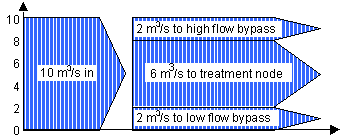Generic Treatment Devices
MUSIC allows you to simulate the performance of any other treatment measure, that is not included in the default range of treatment measures provided. For example, you may wish to compare the performance of a stormwater strategy which used only non-structural methods (community education, etc) with the installation of a gross pollutant trap.
music therefore provides a Generic Treatment Node, for which the user describes the performance using a series of transfer functions.
Generic Treatment Node Properties Dialogue Box
Location
The location name will be displayed under the generic treatment node icon on the main worksheet.
Inlet Properties
Low Flow Bypass
All of the stormwater that approaches the generic node below the user-defined Low Flow Bypass amount (in units of m3/s) will bypass the node. Any flow above the Low Flow Bypass (subject to the presence of a High Flow Bypass) will enter and be treated by the node.
High Flow Bypass
When the stormwater inflow rate exceeds the user-defined High Flow Bypass amount (in units of m3/s), only a flow rate equal to the High Flow Bypass (less that specified in any Low Flow Bypass) will enter and be treated by the node. All of the stormwater flow in excess of the High Flow Bypass amount will bypass the node and will not be treated.
Transfer functions operate in the same way as in Gross Pollutant Traps. Refer to Gross Pollutant Traps for more infromation.
It is possible to record flux data for the Generic Treatment Node:
- inflow rate and water quality
- outflow rate and water quality
- low and high flow bypass rate and water quality
- total outflow rate (sum of outflow and bypasses) and water quality.
Refer to Fluxes for more information about fluxes.
The Notes button allows you to record any important details or assumptions for the Generic Treatment Node (for example, you may provide an explanation of the nature of the targeted community education program, and how its performance was predicted or calculated). It is good practice to provide notes of any important assumptions used in creating the model.




